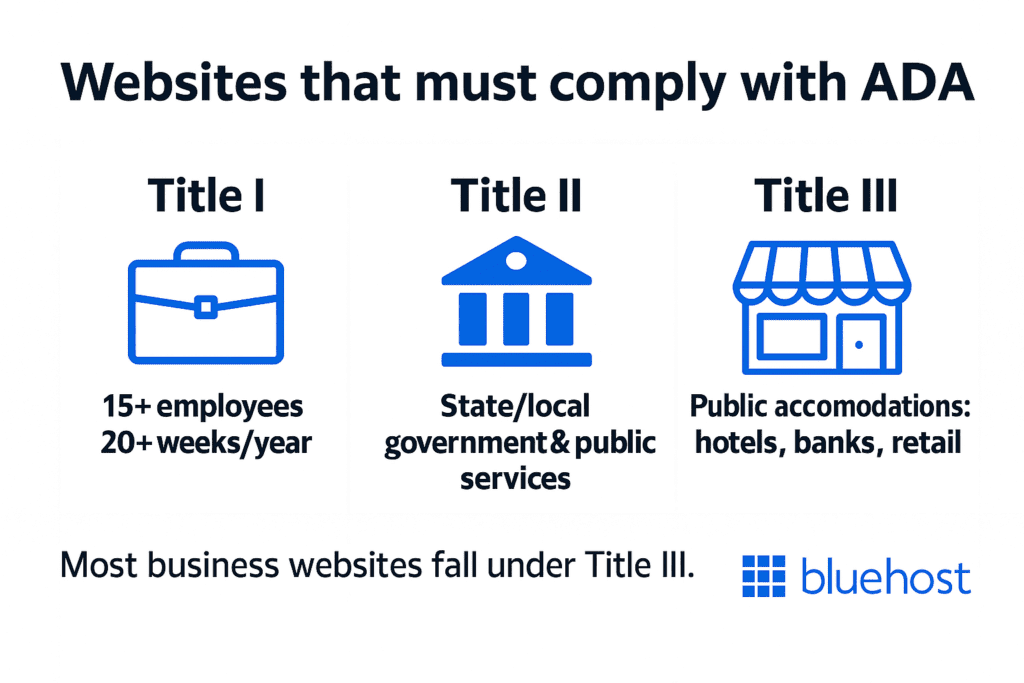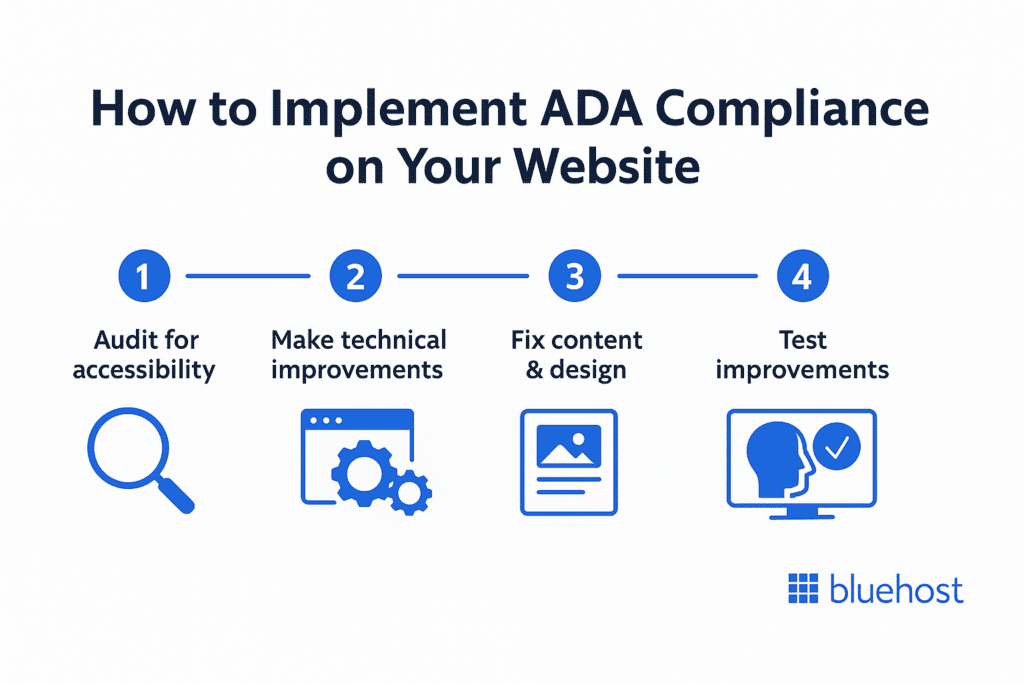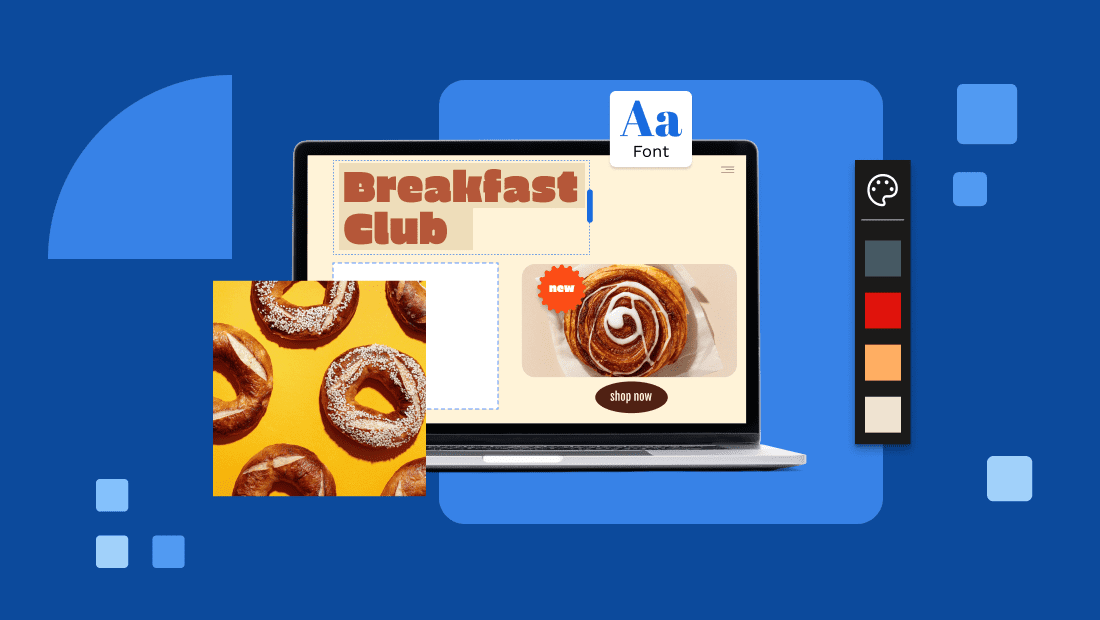Key highlights
- Comply with ADA Title III requirements to avoid lawsuits with penalties up to $50,000.
- Implement WCAG 2.1 AA standards to achieve proper ADA compliance for your website.
- Add accessibility features for websites to improve user experience and expand your market reach by 15-20%.
- Conduct regular accessibility audits as your website content changes and accessibility standards evolve.
- Install proper alt text, keyboard navigation, and color contrast to make significant accessibility improvements.
Your website might be turning away one in five potential customers without you even realizing it.
When millions of Americans navigate the web with disabilities, they encounter accessibility barriers on non-accessible sites. These barriers—from unlabeled visual elements to keyboard-inaccessible forms—create frustrating dead ends where users simply give up and leave.
This is why ADA website compliance has become essential for website owners. It makes your website accessible to everyone while protecting you from the legal complications that catch many companies off guard.
This guide cuts through the confusion of web accessibility with straightforward solutions you can implement today. You’ll discover how proper headings, alt text and keyboard navigation create better experiences for all users while protecting your business from potential penalties.
The technical aspects might seem overwhelming at first, but the right approach makes accessibility compliance completely manageable.
Ready to make your website work for everyone? Let’s dive in.
What is ADA compliance?
ADA compliance refers to following the requirements of the Americans with Disabilities Act (ADA) to make digital content accessible to people with disabilities. For websites, it means implementing specific design and functionality standards that ensure everyone, regardless of ability, can access and navigate your site effectively.
ADA was passed in 1990 to prohibit discrimination against individuals with disabilities in all areas of public life, including digital spaces.
While the original legislation didn’t explicitly mention websites, the Department of Justice (DOJ) has interpreted Title III to apply to both physical and digital spaces.
The DOJ is the one who enforces ADA compliance through investigations and legal actions against non-compliant businesses.
In 2010, they passed the Americans with Disabilities Act Standards for Accessible Design. This mandate requires all electronic and information technology to be accessible to people with disabilities.
Which websites must comply with ADA?
ADA requirements apply to websites for businesses and organizations that serve the public. Your website must comply if you run:
- Title I organizations: Businesses with 15 or more employees operating 20+ weeks per year
- Title II entities: State and local governments and public entities
- Title III entities: Places of “public accommodation” such as hotels, banks, retail stores and other businesses

Most commercial websites fall under Title III. Courts have consistently ruled that websites qualify as places of public accommodation. This means your business website likely needs to follow ADA compliance guidelines.
As a website owner, once you understand who is exempt from ADA compliance, it can save unnecessary work.
What happens if my website isn’t ADA compliant?
Non-compliance carries significant risks:
- Legal consequences: Your businesses could face increasing numbers of lawsuits, with settlements often reaching $10,000-$50,000 plus legal fees.
- Reputational damage: Public perception of your brand suffers when you exclude people with disabilities.
- Lost customers: About 15-20% of website visitors have some form of disability—non-compliance means losing potential customers.
- Decreased SEO: Many web accessibility elements also improve search engine rankings.
David Engelhardt, a small business attorney, explains: “The business will have to pay attorneys’ fees, which can be tens of thousands of dollars. Depending on the state, the business owner can be looking at a $50,000 bill.” (Gil v. Winn-Dixie)
How does WCAG relate to ADA compliance?
The Web Content Accessibility Guidelines (WCAG 2.1) provide a framework for making web content accessible. These internationally recognized accessibility standards for websites from the World Wide Web Consortium offer specific, measurable criteria for digital accessibility.
While not officially incorporated into ADA law, WCAG has become the de facto standard courts use to evaluate ADA compliance.
WCAG is structured around four principles, often abbreviated as POUR:
- Perceivable: Users must be able to perceive information and user interface components with their available senses.
- Operable: Users must be able to use interface components and navigation.
- Understandable: Content must be clear and operations must make sense.
- Robust: Content must remain accessible with current and future tools.
WCAG offers three conformance levels:
- Level A: Minimal accessibility
- Level AA: Standard target for most accessible websites (recommended for ADA compliance)
- Level AAA: Highest level of accessibility (exceeds requirements)
Most experts recommend achieving WCAG 2.1 Level AA to meet ADA requirements. This provides good accessibility while remaining practical to implement.
What are the core requirements for ADA website compliance?
Core ADA website compliance requirements focus on five key accessibility areas: visual elements, keyboard navigation, multimedia content, forms, and clear content structure. These requirements ensure your website works for all users across different browsers and devices.
The table below outlines the most important elements you need to implement for WCAG 2.1 AA compliance. These technical requirements translate the broader POUR principles into specific, actionable criteria.
| Category | Requirement | Description |
| Content alternatives | Text alternatives | Provide text descriptions for all non-text content, including images, videos and audio |
| Captions | Include synchronized captions for all pre-recorded and live video content | |
| Audio descriptions | Add narration that describes important visual elements in videos | |
| Presentation | Adaptable content | Ensure content can be presented in different ways without losing information |
| Color contrast | Maintain at least 4.5:1 contrast ratio between text and background | |
| Resize text | Allow text to be resized up to 200% without loss of content or function | |
| Images of text | Avoid using images of text except for logos and essential formatting | |
| Navigation | Keyboard accessible | Make all functionality available through keyboard interface |
| Enough time | Provide users sufficient time to read and interact with content | |
| Multiple ways | Offer different methods to find content (search, menus, site maps) | |
| Focus visible | Ensure keyboard focus indicator is clearly visible at all times | |
| Understanding | Language | Identify the web page language and any language changes in content |
| Consistent navigation | Maintain consistent navigation patterns across all pages | |
| Input assistance | Help users avoid and correct mistakes in form submissions | |
| Compatibility | Parsing | Ensure clean, standards-compliant code that works with assistive technology |
| Name, role, value | All interface components convey their purpose to assistive tech |
These requirements form the foundation of an accessible website. Implementing these elements helps ensure your site is usable by people with a wide range of disabilities. In addition, this way, your website can also meet legal compliance standards under the ADA.
Let’s now look at the most important requirements you need to meet:
1. Visual accessibility elements
Visual accessibility ensures people with vision impairments can equally access web content. This includes accommodations for blind users, those with low vision and people with color blindness. Your site must provide alternate ways to perceive visual information.
How should I make my website visually accessible?
- Add descriptive alt text to all images that convey information.
- Maintain at least 4.5:1 color contrast ratio between text and background colors.
- Ensure content remains visible and functional when zoomed to 200%.
- Use relative units (em, %) instead of fixed pixel sizes.
- Create a consistent, predictable layout with clear visual hierarchy.
- Never use color as the only way to convey important information.
Also read: Color Contrast for Accessibility: A Color Psychology Guide
2. Keyboard navigation accessibility
Many users with disabilities cannot use a mouse. They rely entirely on keyboard navigation commands to navigate websites. All interactive elements must work without requiring a pointing device.
How should I make my website keyboard accessible?
- Ensure all interactive elements work with keyboard-only navigation.
- Create a logical tab order that follows the visual layout of the page.
- Provide visible focus indicators so users know their current position.
- Add skip navigation links to bypass repetitive content.
- Ensure dropdown menus and complex widgets work with keyboard commands.
- Test your entire site using only keyboard controls.
3. Multimedia accessibility
Videos and audio files need special considerations for web accessibility. Users who are deaf or hard of hearing cannot perceive audio content, while blind users miss visual information. Accessible alternatives must accompany all multimedia.
How should I make multimedia content accessible?
- Add synchronized captions to all videos that include speech and important sounds.
- Provide audio descriptions of key visual elements for videos when needed.
- Create text transcripts for audio content with speaker identification.
- Avoid autoplay and give users control over media playback.
- Include volume controls and options to pause or stop media.
- Ensure media players themselves are accessible via keyboard.
4. Form accessibility
Interactive forms present unique accessibility issues on websites. Errors with form labels, validation and feedback can prevent users with disabilities from completing essential tasks. ADA compliance requires accessible form design.
How should I make my forms accessible?
- Associate each form field with a descriptive label using the “for” attribute.
- Clearly indicate required fields both visually and in code.
- Provide clear error messages that explain specifically what went wrong.
- Use both color and text to indicate errors (never color alone).
- Allow users to navigate and submit forms using only a keyboard.
- Give clear instructions for any formatting requirements.
5. Content clarity
Clear, well-structured content helps users with cognitive disabilities and benefits everyone. Accessible content uses simple language and logical organization with proper headings.
How should I make my digital content accessible?
- Structure content with proper hierarchical headings (H1-H6).
- Use plain language instead of jargon or complex terminology.
- Break text into short paragraphs with adequate spacing.
- Provide instructions for complex interactions or processes.
- Maintain consistent navigation patterns throughout your site.
- Include a site search function as an alternative navigation method.
Also read: Learn How To Structure Your Website To Boost Your SEO
How can I implement ADA compliance on my website?

Implementing accessibility is a systematic process. Modern web accessibility standards apply to both websites and mobile apps. To make your mobile app accessible, you’ll use similar principles as websites but with mobile-specific considerations. Follow these steps to make your website ADA compliant:
1. Conduct an accessibility audit
An accessibility audit is a comprehensive review of your website to identify barriers for users with disabilities. This crucial first step reveals what needs fixing.
- Use automated testing tools: WAVE, axe DevTools and Lighthouse can quickly scan your site for basic accessibility problems. These tools catch common issues like missing alt text and color contrast violations.
- Perform manual testing: Check your site with keyboard-only navigation and screen readers. Automated tools miss many contextual problems that require human judgment.
- Invite users with disabilities: Nothing replaces actual user testing. Ask people with different disabilities to navigate your site and provide feedback on difficulties they encounter.
- Create a prioritized list: Document all issues found and organize them by severity. Fix accessibility issues first, then address minor issues later.
2. Make technical changes to improve accessibility
The technical foundation of your website affects overall accessibility. After your audit, implement these technical improvements:
Use semantic HTML structure
Semantic HTML uses elements that clearly describe their meaning to browsers and assistive technologies. This structural foundation helps screen readers interpret your content correctly. Replace generic containers with specific elements:
<!-- Instead of this -->
<div class="header">Welcome</div>
<div class="navigation">Menu items...</div>
<!-- Use this -->
<header>Welcome</header>
<nav>Menu items...</nav>
Add ARIA attributes
Accessible Rich Internet Applications (ARIA) attributes provide additional information to assistive technologies when HTML alone isn’t sufficient. These attributes help clarify the purpose and state of complex elements:
<button aria-expanded="false" aria-controls="dropdown-menu">
Menu
</button>
<div id="dropdown-menu" aria-hidden="true">
<!-- Menu content -->
</div> Only use ARIA when necessary. Native HTML elements with built-in accessibility work better when available.
Specify document language
Screen readers need to know which language your content uses to pronounce words correctly. Specifying the language helps all assistive technologies present your content properly:
<html lang="en">
<!-- Page content -->
</html> For content in other languages, use language attributes on specific elements:
<p>The French word <span lang="fr">bonjour</span> means hello.</p>
3. Fix your content and design
Content and visual design significantly impact accessibility. Understanding these elements helps you create an inclusive experience.
- Use text alternatives: Add descriptive alt text to informational images so screen readers can communicate visual content to blind users. Use empty alt attributes for decorative images.
- Write descriptive link text: Use specific descriptive phrases instead of generic “click here” or “read more” links. This helps all users understand where links lead without relying on surrounding context.
- Structure content with proper headings: Organize content with H1-H6 headings in a logical hierarchy to help screen reader users navigate your page efficiently.
4. Test your improvements
Testing validates your accessibility efforts. Different testing methods reveal different types of issues.
- Verify fixes with automated tools: Re-running automated scans after making changes confirms you’ve resolved identified issues. These tools quickly verify technical compliance with many WCAG requirements. They also help catch new problems introduced during fixes.
Also read: Top 10 WordPress Accessibility Plugins in 2024
- Test with actual assistive technologies: Screen readers and other assistive technologies reveal how users with disabilities actually experience your site. Testing with NVDA, JAWS or VoiceOver helps identify issues automated tools miss. Try navigating without a mouse to ensure all functions work with keyboard alone.
- Gather insights from disabled users: Invite people with various disabilities to test your site and provide feedback on real-world usability. Their perspective reveals whether your technical solutions effectively address accessibility barriers.
What are the benefits of ADA website compliance?
ADA compliance delivers advantages that extend beyond legal protection. Making your site accessible provides these key benefits:
- Expanded audience reach (15-20% more potential customers)
- Improved SEO performance and search rankings
- Better user experience for all visitors
- Reduced legal risk and compliance costs
- Enhanced brand reputation and customer loyalty
- Improved mobile usability across devices
Let’s now explore each benefit in detail:
1. Simplify navigation for all users
Clear navigation helps everyone find information faster. Logical structure makes your site more efficient for all website visitors, not just people with disabilities. This creates a better experience that keeps users on your site longer.
2. Optimize for mobile and different devices
Accessibility improvements directly enhance mobile usability. Your responsive design works better across all devices and screen sizes. Most accessibility features also improve how your site performs on smartphones and tablets.
Also read: Mobile Optimization in 2025 – Best Practices
3. Reduce form abandonment and errors
Clear instructions and helpful error messages keep users on task. This results in fewer abandoned forms and more completed transactions. Accessible forms lead directly to higher conversion rates.
4. Expand your potential customer base
People with disabilities represent 15-20% of the population with billions in purchasing power. Including this demographic directly increases your revenue potential. Their friends and family often make buying decisions based on accessibility as well.
5. Improve search engine rankings
Accessibility features like proper headings, alt text and transcripts boost your SEO. Search engines reward the same structure that helps screen readers. Your accessible content becomes more discoverable for all users.
6. Build stronger customer trust
Demonstrating inclusivity strengthens your brand reputation. Your commitment to accessibility shows the social responsibility that modern consumers value. This builds loyalty with an increasingly conscious market.
How Bluehost can help you achieve ADA compliance?
Creating an ADA-compliant website requires technical expertise and the right tools. Many website owners find the implementation process challenging and time-consuming. Bluehost offers specialized solutions to simplify your path to compliance.
Our Professional Website Design Services provide the most direct route to ADA compliance. Our accessibility experts can build a compliant site from scratch or retrofit your existing site to meet accessibility standards.
Each design incorporates proper semantic structure, accessible navigation patterns and full compliance with WCAG 2.1 AA guidelines. This hands-off approach saves you countless hours of research and implementation.
For those who prefer a hands-on approach, our WordPress AI Website Builder helps you create an accessible site yourself with AI-powered assistance. The builder includes built-in accessibility features and guidance to ensure your DIY site meets compliance standards.
Beyond our design services, Bluehost provides several tools to support your accessibility efforts:
- Accessibility-ready WordPress themes with proper heading structure and keyboard navigation built-in
- Specialized accessibility plugins available directly from your Bluehost dashboard
- Staging environment for testing accessibility changes without affecting your live site
- Comprehensive knowledge base with specific articles on WordPress accessibility
- Expert support team trained to help with accessibility plugin configuration
- Automatic WordPress updates to maintain compatibility with assistive technologies
- Reliable backup system to protect your accessible site from data loss
Whether you choose our professional services or implement compliance yourself, Bluehost provides the foundation for an accessible website. Our platform’s speed, reliability and security create an optimal environment for assistive technologies to function properly, ensuring all visitors can access content.
Final thoughts
ADA website compliance isn’t just a legal requirement—it’s an opportunity to serve all your visitors better. By implementing these accessibility standards for websites, you improve user experience while protecting your business from potential legal issues.
Remember that accessibility is an ongoing process. Start with critical areas first, then continue making improvements over time. Regular testing ensures your site remains compliant as content changes and standards evolve.
Bluehost Professional Website Design Services team can handle all your ADA compliance needs so you can focus on your business. Our experts build sites with accessibility features built-in from the ground up.
In addition to design services, we also offer specialized WordPress hosting solutions to support your accessible website. Our hosting platform includes tools and resources specifically designed to maintain website accessibility standards.
Ready to make your website more accessible? Call us today at 866-757-1828 or visit Bluehost.com to get started with our accessibility-focused hosting and design services.
FAQs
Yes, if your business falls under Title I (15+ employees) or Title III (public accommodations) of the ADA. Courts have consistently ruled that websites are places of public accommodation, making compliance mandatory for most business websites.
Generally, personal websites, blogs without commercial intent and organizations with fewer than 15 employees may be exempt. However, even exempt organizations should consider accessibility best practices as they provide better user experiences and protect against future regulatory changes.
Costs vary based on site complexity:
1. Small websites: $1,000-$5,000
2. Medium websites: $5,000-$25,000
3. Large websites/apps: $25,000+
However, these costs are much lower than the potential $50,000+ for an ADA lawsuit.
Accessibility widgets provide helpful features but don’t ensure complete compliance. They should supplement, not replace, proper accessibility implementation. Courts have ruled that widgets alone aren’t sufficient for ADA compliance.
Conduct full accessibility audits:
1. Quarterly for active websites
2. After major content or design changes
3. When new WCAG guidelines are released
Regular monitoring helps catch issues before they become problems.
While the ADA is primarily enforced by the Department of Justice (DOJ), most website compliance cases come through private lawsuits. The DOJ can investigate complaints, issue rulings, and impose penalties, but individuals with disabilities can also file lawsuits against non-compliant businesses. This dual enforcement approach has led to thousands of accessibility lawsuits annually.
Good accessibility can coexist with attractive design. Many accessibility features enhance design through:
1. Cleaner layouts
2. Better organization
3. Improved readability
4. Enhanced user experience



Write A Comment